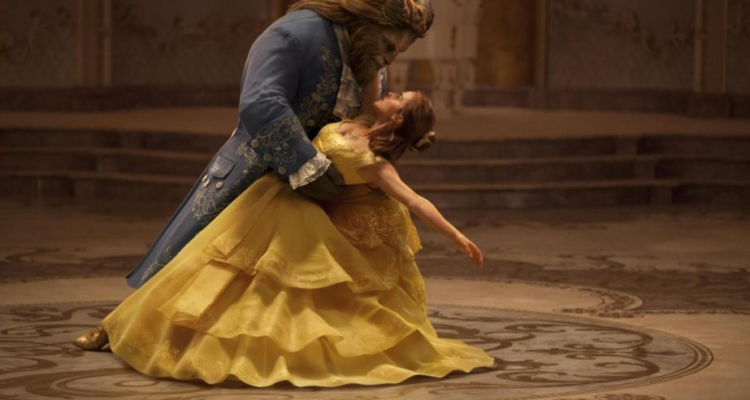Few sequels live up to their first instalments and even fewer remakes live up to the original, but Beauty and the Beast has done the impossible and not only equalled but outstripped its source material. It’s everything you know and love about the 1992 animated film, but better. Belle is more beautiful, the Beast is more beastly and the original songs (by Alan Mencken and the late Howard Ashman) are wonderful, extended versions of themselves, with a few new tunes (written by Menken and Tim Rice) thrown in for good measure.
A stand-out is Celine Dion’s distinctive vocals on “How Does A Moment Last Forever”, a new Menken song. Everything that you remember, the emotional moments, the romance, the suspense and sensational ending is exactly as you remember it, but tenderly and beautifully brought to life by director David Condon.
 The production values leap off the screen in the form of beautiful, sparkling CGI. The ornate Gothic castle decoration, the beautifully delicate costumes and impeccably planned sets and props are a testament to a director with a eye for detail and experience working with larger than life musicals. Condon, who directed Dreamgirls, among other musicals, has this in spades.
The production values leap off the screen in the form of beautiful, sparkling CGI. The ornate Gothic castle decoration, the beautifully delicate costumes and impeccably planned sets and props are a testament to a director with a eye for detail and experience working with larger than life musicals. Condon, who directed Dreamgirls, among other musicals, has this in spades.
 One of the best examples of this is the “Be Our Guest” scene, in which crockery, cutlery and table cloths fly across a vast dining hall, candlelight glinting off the silverware and gold as Lumière (Ewan McGregor) prepares an elaborate feast for Belle. It’s a feast for the eyes and a textbook example of well-handled CGI transforming animation into “real life” for anyone that appreciates rich cinematography.
One of the best examples of this is the “Be Our Guest” scene, in which crockery, cutlery and table cloths fly across a vast dining hall, candlelight glinting off the silverware and gold as Lumière (Ewan McGregor) prepares an elaborate feast for Belle. It’s a feast for the eyes and a textbook example of well-handled CGI transforming animation into “real life” for anyone that appreciates rich cinematography.
One of the best things about this movie is just how human all of the non-human characters are. This applied most notably to the Beast – motion capture makes Dan Stevens (Downtown Abbey) taller, hairier and yes, more beastly, but the character retains humanity in gestures, facial expressions, dance movies, but more importantly in his eyes. It’s easy to write off a Beast that is nothing but animalistic, but is is far harder not emphasise with a Beast who’s humanity so clearly and visibly trapped inside him.
The same goes for Lumière, Cogsworth (Sir Ian McKellan), and company – their faces are so clearly emblazoned on their non-human forms that one can’t help but become invested in their plight as much as the Beast’s. It’s exciting when well-known material delivers something extra while not detracting from the original, causing you to wonder why it wasn’t there all along. The best example of this is the raising of the stakes for the secondary characters imprisoned in the castle along with the Best. If he doesn’t find love and break the spell, they will be forever doomed and will lose the ability to communicate with one another, let alone be returned to human form. Some of the most uplifting moments in the movie are when Lumière, Cogsworth, Mrs Potts (Emma Thompson), Chip and the rest of the singing, dancing flatware and furniture become their original selves again. For actors that are onscreen for less than five minutes, their palpable joyfulness leave a real impression on the audience.
 Of course, it would be remiss not to mention Gaston (Luke Evans) and Le Fou (Josh Gad). Gaston is the Disney equivalent of the arrogant leader of a frat house, with Le Fou tagging alongside for the free beer and reflected glory. They’re singing, dancing and physical comedy is worth the price of admission, not to mention Evans is a sight for sore eyes as he dances on tables and waves his ponytail around.
Of course, it would be remiss not to mention Gaston (Luke Evans) and Le Fou (Josh Gad). Gaston is the Disney equivalent of the arrogant leader of a frat house, with Le Fou tagging alongside for the free beer and reflected glory. They’re singing, dancing and physical comedy is worth the price of admission, not to mention Evans is a sight for sore eyes as he dances on tables and waves his ponytail around.
Belle’s beleaguered father Maurice (Kevin Kline) also suffers an unexpectedly dark storyline with extra elements padding out his backstory to give you a deeper version of the character that was originally just a slightly unhinged inventor. The relationship between Maurice and Belle is also explored much more in this film, and the revelation of the fate of Belle’s mother is yet another example of extra investment in supporting characters.
The best part of the film is Belle. Not only is the exceptionally talented Emma Watson one of this generation’s great beauties, but there’s a feminist fire in her that few characters inhabiting sixteenth century French villages could ever muster. With a quiet dignity, Watson injects a great deal of power into a role that has been slammed in the past as nothing more than an advanced case of Stockholm syndrome. She doesn’t allow the Beast to get away with his roaring temper-tantrums for one second and she doesn’t pander to his demands, instead engaging with him only on topics of mutual interest, like his book collection.
Everything from her disgust at the prospect of being Mrs Gaston to her determination to escape the prison of first her village and then the Beast’s castle screams that Belle has undergone a radical change since 1992. What’s thankfully missing from this performance is overblown, emotional outbursts about love at first sight and melodramatic rescue missions that seems to plague Disney princesses. Belle keeps her cool, defeats Gaston and saves herself and her father and the Beast, all the same time and all while wearing a skirt and holding a book.
A line from one of the original songs actually sums up this film the best – “There may be something there that wasn’t there before.”
Beauty and the Beast will be released in Australia on March 22. Watch the trailer here.









Leave a Reply